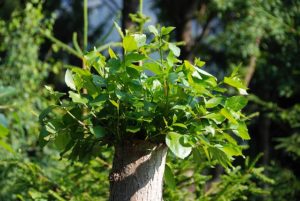
Last Christmas, we received a poinsettia via a harried florist deliveryman. As he thrust the plant into my hands, I noticed several branches were damaged; others, thin and weak. I propped the damaged branches and petted the plant through the Christmas season and into the first month of the new year.
By mid-January, the plant looked especially hopeless and I decided to throw it out, reasoning I had wasted enough effort and it was past its prime. In fact, I had the poinsettia in the trash when an internal voice said, give it a second chance. So I plucked the plant out of the trash, repotted it in fresh soil, and gave the branches a drastic pruning, rendering the plant even more pitiful-looking than before. But a few weeks later, I noticed tiny leaves protruding from those ugly, short stalks. The plant grew, and in the spring, I moved it to our deck. Soon the poinsettia was lush and green, new life flourishing.
Have you given up on certain areas of your life, feeling they are beyond hope?
Here are some reasons to encourage new growth in barren or damaged areas of your life:

Old Wounds Can Yield New Growth
Years ago, a large tree in our backyard crashed to the ground in the middle of the night. The tree’s demise wasn’t the result of a storm or high winds. Instead the root system had decayed from an over-moist environment and insect activity.
Because the tree was so big, and split when it fell, removal was an involved process that tore up sections of our yard. The part of the stump that remained, and the surrounding ground, was unsightly. We didn’t do much to improve the looks of the area that winter, but in the spring, planted some tall flowers in front of the stump and did what we could to smooth the surrounding ground.
During the summer, I noticed something behind the flowers and investigated. A green shoot rose from the unsightly stump! What appeared to be dead was alive and making a new attempt.
It can be the same in our lives. We all have wounds and sometimes hide those wounds behind humor or perfectionism. But those wounds can fester and cause problems if not dealt with and allowed to heal. Moving beyond damage requires intentional effort. In order for new growth to occur, you may need to forgive or let go of resentment. You can’t maintain forward motion if you are continually reopening wounds or harboring hatred. Although scars may remain, new growth is possible.

Patience Allows for a Second Chance
I derive joy from watching plants flourish. It inspires me to see new growth from what looks like a dead stick. I feel a sense of accomplishment when a flower blooms in one of the pots I tend on my deck. But one thing I’ve learned over the years is you can’t force growth or blooms. Oh, I’m sure there are master gardeners or nursery owners out there who know how to force plants to bloom, but most of us have to be patient and accept that growth is often a slow process. While you can work toward optimum conditions for growth, time is part of the equation.
Often, we run ahead of growth that is in process in our lives. We become impatient with the time frame, or restless with the discomfort, and dash headlong into something else instead of waiting to see what growth produces. Learn to be patient while growth occurs. Realize growth is incremental and learn with each step along the way. Second chances often bring change and unexpected beauty.

New Growth Signals Restoration
In watching the poinsettia change from unsightly to a full, lush plant, I saw a reflection of the restoration that can occur in our own lives with patience and nurture. Early in the process, a positive outcome seemed iffy, but time produced restoration.
What areas of your life seem hopeless—relationships, finances, health, addiction, spiritual understanding?
God is a restorer and redeemer. Ask Him to help you prune persistent negative attitudes, actions, and patterns of behavior. Initially, the process may be difficult, even painful, but ultimately produce beautiful results.
“Out of the stump of David’s family will grow a shoot—yes, a new Branch bearing fruit from an old root.” Isaiah 11:1 NLT
©CandyArrington


1 Comment